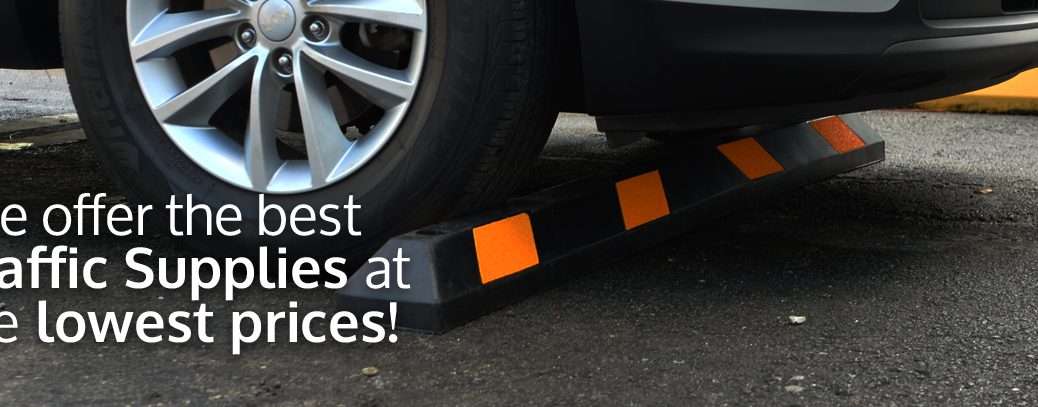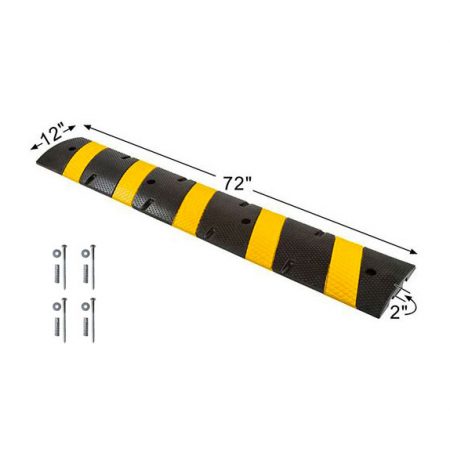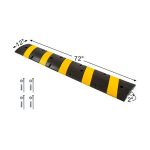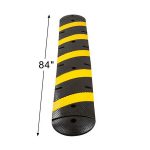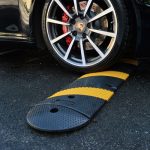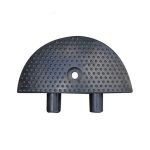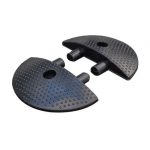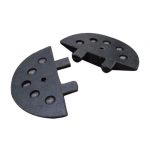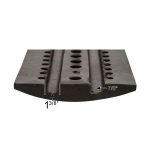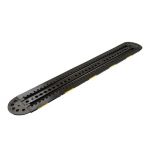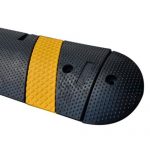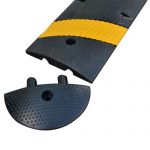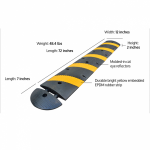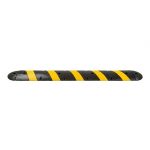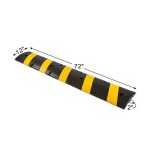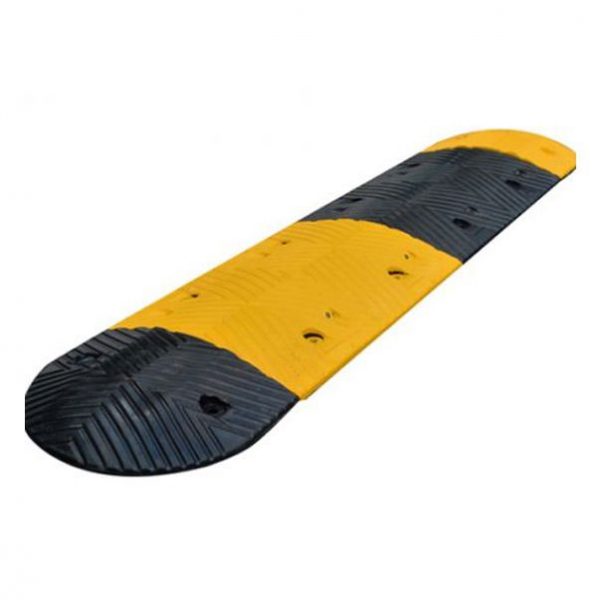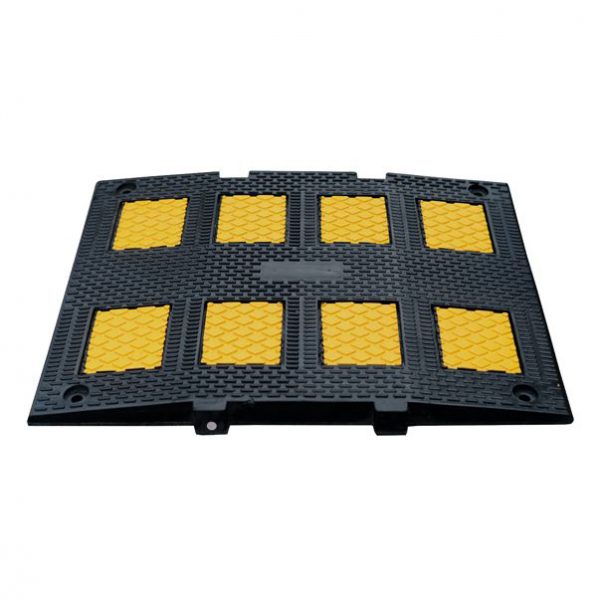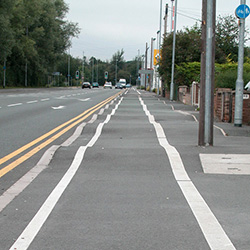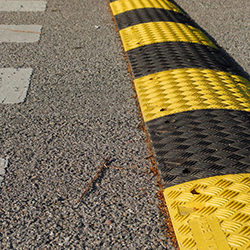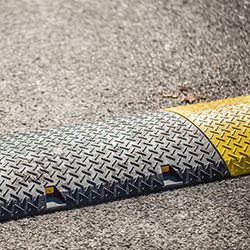Speed Bumps are safe and easy for one person to transport and install. Unimat traffic products are high quality and will help maintained schools, parking lots and roads safe, we sell the best speed bump kits in the market at a very low price. Unimat speed bumps are a great way to instantly calm and reduce vehicle traffic speed in a specified location for a temporary period. We are experts in speed bumps, call us to advise you in this area, our products can be removable and are designed exclusively to make easy to calm traffic during certain hours near school yards and playgrounds or during community events and fairs.
There are great benefits when using speed bumps
Maintain a safe pedestrian environment by slowing down vehicle traffic with our Speed Bumps. Our prices are the lowest in the market and they include the hardware, speed bump can permanently be installed on asphalt or concrete using its pre-drilled countersink mounting holes. Maintain a safe pedestrian environment by slowing down vehicle traffic with our great 6’ heavy-duty economy speed bumps. Our products will give you total satisfaction and your roads will be safe and people as well, areas like parking lots and much more will be protected. Unimat plastic traffic bumps have molded reflective tape and include cat’s eye reflectors that will increase visibility during the day and night. Speed bumps are used in areas where vehicles need to proceed at much slower speeds, like school zones, public parks, parking buildings, private condominiums and many others. Plastic speed bumps have become the traffic control tool of choice for many of our customers because they are extremely simple install. We offer a variety of sizes with high quality and excellent durability. Our plastic speed bumps have many benefits, we have all products available in stocks and ready to ship right away!Places where speed bumps can be used!
Speed bumps can be located in many different area, they will help maintained schools, parking lots and roads safe, also outside schools, community centers, public areas where more vulnerable people might be at risk, they can be placed in addition in residential areas where families and other at-risk people may often be walking, these products are perfect for zones where cars often break a residential speed limit. Speed bumps are great also for indoor and outdoor car parking spaces where a high volume of usually slow-moving vehicles are at risk of collisions with those breaking the speed limit. Our products can be removable and are designed exclusively to make easy to calm traffic during certain hours near school yards and playgrounds or during community events and fairs.Top quality speed bumps and the lowest prices guaranteed
The sooner you know the traffic signals much better, this should be the basic premise of this type of courses. Throughout the courses, children, among other things, learn the meaning of: pedestrian crossing, zebra crossing, bus stop, STOP, direction required, forbidden direction, traffic light (what is, their implications in the passage of pedestrians, etc …) In this way they learn to differentiate all elements of public roads: sidewalk, curb and road, knowing where and how to cross. This are a very important road tool to have to maintain people safe in your garage are, residential area, hospitals, school, government buildings, etc Call us today for a quote, we offer discount for large quantities and special pricing for distributors.| SKU | Description | Length | Height | Width | Weight |
|---|---|---|---|---|---|
| SB206FT | 6 Ft Speed Bump (1) 6′ Section With no End Caps | 72″ | 2″ | 12″ | 48.40 |
| SB207FT | 7 Ft Speed Bump (1) 6′ Section + (2) End Caps | 86″ | 2″ | 12″ | 55.40 |
| SB213FT | Single Lane 12 Ft Speed Bump (2) 6′ Section With no End Caps | 144″ | 2″ | 12″ | 96.80 |
| SB219FT | Double lane 19 Ft Speed Bump (3) 6′ Section + (2) End Caps | 230″ | 2″ | 12″ | 152.20 |
| SB225FT | 25 Ft Speed Bump (4) 6′ Section + (2) End Caps | 302″ | 2″ | 12″ | 200.60 |
| SB2ECAP | End cap | 7′ | 2′ | 12′ | 3.50 |
Speed Bump Kits Manufacturer
Our products are not only great quality but also they have the lowest prices in the market since we are Manufacturer and have different packages for Distributors and Suppliers, you can single units or Wholesale at a very low cost. We have clients all over the world, we are fully stocked and can ship right away. We have the lowest prices of the market. Our customer service representatives are always ready to assist you and can answer any technical and specific questions.
Special discounts on orders of 100 pieces or more Contact us at discounts@unimat-traffic.com
Volume Pricing – Hardware Included
Save
$
$74.98
each
Quantity 1-49
$68.50
each
Quantity +50
- Cat Eye reflectors to optimize night vision and darkness vision.
- Reflecting Yellow ribbon.
- Bottom with canals to help facilitate drainage, to set the wiring or street pipes.
- Made of tire rubber 100% recycled
Mounting screws INCLUDED. We are the only ones that include the hardware for free.
Included HARDWARE OPTIONS:
 Asphalt
Asphalt Concrete
Concrete
Placement
 Asphalt
Asphalt Concrete
Concrete
- Asphalt and concrete
- Streets
- Parking Lots
Standard Sizes
For larger quantities please contact a representative for additional pricing discounts. 1-855-864-6281
| SKU | Description | Length | Height | Width | Weight | Quantity 1- 49 | Quantity 50+ |
|---|---|---|---|---|---|---|---|
| SB206FT | 6 Ft Speed Bump (1) 6′ Section With no End Caps | 72″ | 2″ | 12″ | 48.40 | $74.98 | $68.50 |
| SB207FT | 7 Ft Speed Bump (1) 6′ Section + (2) End Caps | 86″ | 2″ | 12″ | 55.40 | $98.00 | $92.50 |
| SB213FT | Single Lane 12 Ft Speed Bump (2) 6′ Section With no End Caps | 144″ | 2″ | 12″ | 96.80 | $173.96 | $170.48 |
| SB219FT | Double lane 19 Ft Speed Bump (3) 6′ Section + (2) End Caps | 230″ | 2″ | 12″ | 152.20 | $285.94 | $280.22 |
| SB225FT | 25 Ft Speed Bump (4) 6′ Section + (2) End Caps | 302″ | 2″ | 12″ | 200.60 | $372.92 | $365.46 |
| SB2ECAP | End cap | 7″ | 2″ | 12″ | 3.50 | $12.50 | $12.50 |
Specifically designed to stop high speed traffic on streets and parking lots, Unimat rubber speed bumps are a smart solution to ensure a safe street and parking lot.
The rubber speed bumps are a smart investment since they don’t need any maintenance. Their rubber construction makes them last much longer than if they were made of other materials.
Use Unimat rubber speed bumps and take advantage of their outstanding features. They also have cat eye reflectors that allow them to be visible during night hours.
Features & Benefits of the rubber speed bumps
- Made of 100% recycled tire rubber, it is a flexible design; it fits on almost any highway surface to stop cars.
- Reflecting yellow ribbon.
- Cat Eye reflectors to optimize night vision and darkness vision.
- Pre-perforated for easy installing.
- Bottom with canals to help facilitate drainage, to set the wiring or street pipes.
- Our Speed bumps can be easily removed for storage or reinstalling.
- They can be used for temporary or permanent installation.
- Resistant to dampness, oil, temperature variations and ultraviolet rays.
- They won’t lose their shape, crack or get rotten.
- Flexible design allows them to adapt to inequalities of the road.
- Lightweight, they can be easily installed by only one person.
Speed bumps and speed humps are traffic calming devices designed to slow down drivers in certain areas. Speed bumps are made to slow drivers down to between 2 to 5 mph, while speed humps are designed to slow traffic on public roads such as schools. They are made of rubber and are durable and portable. You can find speed bumps and humps for sale online here.
Speed Bumps & Humps For Driveways & Parking Lots
There are several benefits of recycled plastic or rubber Speed Bumps and Speed Humps over regular and traditional asphalt or concrete bumps, and those specific benefits are:- These speed bumps and humps are made out of 100% recycled material that contributes to the ecology.
- Thanks to their colored rubber material they never loose their color or brightness so you will never need to retouch the paint.
- Bumpers and humpers are light weight, easy to transport so it’s a simple one-person installation.
- Easy to remove for pavement maintenance or area maintenance, this helps to facilitate the job and eliminates time to every process.
- No maintenance needed.
- Effective costs because it has years of high performance with low maintenance. These low costs and low maintenance give the clients the opportunity to have a great product without affecting the company budget.
What’s the difference between a speed bump and a speed hump?
Speed Bumps are designed to improve pedestrian safety through slowing down vehicles in areas where slow speed is a must since it reduces the risk of accidents on residential street, driveways and parking lots. The average speed of a vehicle on a speed bump is between 2 to 5 mph. Reinforce the stop signs in parking lots and roads and are made to slow down drivers to between 2 to 5 mph, this helps reducing accidents where you need to almost stop the vehicle in the area. Speed Humps on the other hand, slow down vehicles to between 10 to 15 mph. Slow traffic on public roads such as schools, hospitals, applies to where they need to reduce the speed but not stop a vehicle. Where emergency vehicles transit and they need to keep going. Industrial areas or areas with heavy truck traffic where high speeds can lead to an overturned vehicle or provoke an accident.Yellow Recycled Plastic Speed Bumps
Our online store stocks several different lengths of speed bumps for sale from 6 to 25 inches for immediate shipment. You can combine bumps of different lengths to accommodate any width of parking lot or lane. Choose from our wide variety of speed bumps. All Speed bumps have reflective yellow tape that help to increase safety in low light conditions.Reflective Recycled Rubber Speed Bumps for sale
When we created our reflective recycled rubber speed bumps, we thought about creating an efficient product to improve the safety of pedestrians and motorists, that´s why we used the very best materials for manufacture and made sure we made the best shape and texture to improve its performance and endurance. Our speed reducers are made of highly resistant recycled rubber with two installation holes and reflective yellow tapes that allow much greater visibility at any time of the day, while their one-piece construction notably increases their life time. The covers help for the drivers never notices that there is two parts of the Bump. You can combine bumps of different lengths to accommodate any width of parking lot or lane.Recycled Rubber Speed Humps for Sale
Being much gentler than speed bumps, emergency vehicles don’t need to slow down as much as they do with Speed Bumps maintaining the safety of the areas where they are installed. They are highly visible and reflective. We are sure that either our Speed Bumps or our Speed Humps will exceed all your expectations of quality and durability.
Related Products

